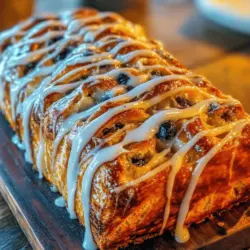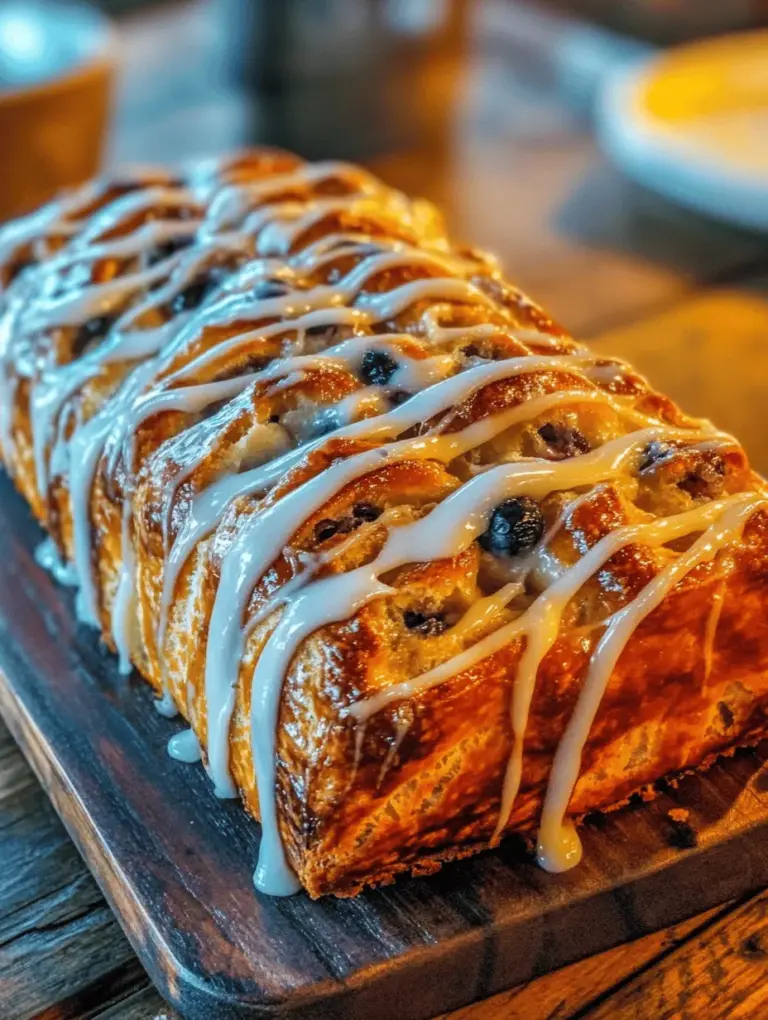Welcome to the world of baking where tradition meets creativity! One such delightful creation is the Blueberry Cream Cheese Babka, a sweet, braided bread that marries soft dough with a luscious filling. This blog post will guide you through the process of making this irresistible treat, perfect for breakfast, brunch, or an afternoon snack. Whether you’re a seasoned baker or just beginning your culinary journey, this recipe will provide you with all the knowledge you need to create a stunning babka that will impress anyone who tastes it.
Understanding Babka: A Brief History
To fully appreciate the Blueberry Cream Cheese Babka, it’s essential to understand its historical roots and cultural significance. Babka, a term derived from the Slavic word for “grandmother,” is a sweet yeast dough that has become an iconic pastry in Eastern European Jewish cuisine. Traditionally, this delightful bread was made with leftover dough and filled with various ingredients, including chocolate, cinnamon, and streusel.
Originally, babka was a humble peasant bread, often baked in a loaf shape to use up scraps of dough and filling. Over time, it grew in popularity, transitioning from a simple dessert to a beloved staple that is often enjoyed on special occasions and holidays. The sweet, braided shape of babka makes it not only delicious but visually appealing, making it a centerpiece for gatherings and celebrations.
In recent years, babka has experienced a renaissance, with modern bakers experimenting with various fillings and flavor combinations. The Blueberry Cream Cheese Babka is a testament to this creativity, combining the rich, creamy texture of cream cheese with the bright, juicy flavor of blueberries. This fusion of flavor profiles offers a delightful twist on the traditional babka, making it a must-try for anyone who loves sweet, homemade bread.
Ingredient Breakdown
Let’s delve into the key components of the Blueberry Cream Cheese Babka. Understanding each ingredient’s role will help you appreciate the complexities of the recipe and ensure you achieve the best results.
1. Flour and Yeast
The foundation of any good bread is high-quality flour and yeast. For this recipe, all-purpose flour is typically used, providing the right balance of protein and gluten that contributes to the dough’s texture. Gluten is essential for creating the elasticity needed for the babka to hold its shape as it rises and bakes.
Yeast plays a crucial role in the leavening process. When activated, it consumes the sugars in the dough and produces carbon dioxide, causing the dough to rise. The result is a light, airy texture that is characteristic of a well-made babka. It’s essential to use fresh yeast for optimal results, as expired yeast may not activate properly, leading to dense bread.
2. Sugar
Sugar is not just a sweetener; it enhances flavor and contributes to the browning of the crust during baking. In this recipe, granulated sugar is used to sweeten the dough and the cream cheese filling. It balances the tartness of the blueberries and helps to create a beautifully golden crust. Additionally, sugar nourishes the yeast, promoting fermentation and aiding in the dough’s rise.
3. Cream Cheese
The star of this babka is undoubtedly the cream cheese filling. Cream cheese adds a rich, velvety texture and a slight tanginess that complements the sweetness of the blueberries. When mixed with powdered sugar, it becomes a creamy filling that is both luscious and satisfying. For the best results, it’s important to use room-temperature cream cheese, as this ensures a smooth and easy-to-spread filling.
4. Blueberries: Fresh vs. Frozen
When it comes to blueberries, you have the option of using fresh or frozen. Fresh blueberries offer a burst of flavor and a lovely texture, making them an ideal choice for this recipe. However, frozen blueberries can also be used, especially if fresh ones are out of season. If using frozen blueberries, make sure to thaw and drain them to avoid excess liquid in the filling. Both options will deliver a delicious result, so choose based on availability and preference.
Preparing the Dough
Step 1: Mixing Dry Ingredients
To create a perfect babka, start by gathering your dry ingredients: flour, sugar, yeast, and salt. In a large mixing bowl, combine these ingredients thoroughly. Make sure to whisk them together to ensure even distribution, which is crucial for consistent results. The salt is particularly important as it enhances the overall flavor and regulates yeast activity.
Step 2: Activating the Yeast
Next, you’ll need to activate the yeast. This is a critical step in the process. In a separate bowl, gently heat milk until it’s warm but not boiling (about 110°F or 43°C). If it’s too hot, it can kill the yeast. Once at the right temperature, sprinkle the yeast over the milk and let it sit for about 5-10 minutes until it becomes frothy. This froth indicates that the yeast is alive and ready to work its magic in the dough.
Step 3: Incorporating Wet Ingredients
Once the yeast is activated, it’s time to combine the wet ingredients. In a large mixing bowl, pour in the activated yeast mixture, followed by melted butter, eggs, and vanilla extract. The butter adds richness, while the eggs provide structure and moisture. Whisk these ingredients together until well combined.
Step 4: Combining Wet and Dry Ingredients
Now, it’s time to bring the dough together. Gradually add the dry ingredients to the wet mixture, stirring with a wooden spoon or spatula until a shaggy dough forms. Once the dry ingredients are incorporated, transfer the dough to a lightly floured surface.
Step 5: Kneading the Dough
Kneading is a crucial step to develop gluten, which gives the babka its characteristic texture. Begin to knead the dough by pushing it away from you with the palms of your hands, then folding it back over itself. Continue this process for about 8-10 minutes until the dough is smooth and elastic. If the dough is too sticky, sprinkle a little more flour as needed, but avoid adding too much, as this can lead to a tough texture.
Tips for Kneading
– Use the Windowpane Test: To check if your dough is kneaded enough, stretch a small piece of dough between your fingers. If it forms a thin, translucent membrane without tearing, it’s ready.
– Resting the Dough: After kneading, place the dough in a lightly greased bowl, cover it with a clean kitchen towel or plastic wrap, and let it rise in a warm place until doubled in size (about 1-2 hours).
Now that your dough is prepared and ready to rise, you’re one step closer to creating a delicious Blueberry Cream Cheese Babka that will tantalize your taste buds. In the next section, we will delve into making the cream cheese filling, which will elevate your babka to new heights of flavor. Stay tuned for the delightful process that follows!
{{image_1}}
Techniques for Forming the Iconic Twist
Creating the perfect Blueberry Cream Cheese Babka involves a blend of technique and artistry. The signature twist not only makes it visually appealing but also ensures that every slice is bursting with flavor. Let’s break down the essential techniques for achieving this iconic braid.
Rolling Out the Dough: Tips for Achieving the Right Thickness
To start, dust your work surface with a light sprinkle of flour to prevent sticking. Carefully roll out the dough into a rectangle, aiming for about ¼ inch thickness. If your dough is too thick, it may not bake evenly or may result in a dense texture. Conversely, rolling it too thin can lead to tearing, making it difficult to spread the filling. When rolling, use gentle pressure and rotate the dough periodically to maintain an even shape. Aim for a rectangle that measures approximately 16 x 12 inches; this size is perfect for creating those beautiful layers.
Spreading the Filling Evenly: Avoiding Mess and Maximizing Flavor
Once you have rolled out the dough, it’s time to spread the blueberry filling and cream cheese mixture. Start by ensuring that your filling is at room temperature; this makes it easier to spread without tearing the dough. Use an offset spatula or the back of a spoon to evenly distribute the filling across the surface of the dough. Be sure to leave a half-inch border along the edges to prevent overflow during the rolling process. This not only helps keep your filling confined but also allows the dough to seal properly, ensuring that the flavors meld together beautifully.
The Art of Twisting: Creating the Beautiful Braid
Now comes the fun part—twisting the dough! Begin by rolling the dough tightly from one long edge to the other, creating a log. Once rolled, gently pinch the seams to secure the filling inside. Using a sharp knife or bench scraper, slice the log in half lengthwise. This will reveal the stunning layers of blueberry and cream cheese.
Next, take the two halves and twist them together, keeping the cut sides facing up. This will create that beautiful, eye-catching braid. It may take a few tries to perfect the technique, but don’t worry—practice makes perfect! Once twisted, carefully place the braided dough into a prepared loaf pan, ensuring it fits snugly but isn’t overcrowded.
Placing the Twisted Dough in the Loaf Pan: Tips for Neat Presentation
When placing your twisted dough into the loaf pan, ensure the cut sides remain facing upward, as this helps showcase the colorful filling once baked. If you notice any gaps or unevenness, gently press the dough together to create a cohesive shape. It’s essential to use a greased loaf pan or line it with parchment paper to make the removal process easier after baking.
Second Rise: The Importance of Patience
Understanding the Proofing Process
After shaping your babka, it’s crucial to allow it to undergo a second rise. Proofing is an essential step that enhances the texture and flavor of your bread. During this phase, the yeast continues to ferment, creating air bubbles that contribute to a light and airy texture.
The Science Behind the Second Rise for Texture and Flavor Development
The second rise allows the gluten structure to relax, ensuring that your babka will rise beautifully in the oven. As the yeast feeds on the sugars in the dough, it produces carbon dioxide and alcohol, which not only leavens the bread but also enhances its flavor profile. This process can take anywhere from 30 minutes to an hour, depending on the temperature of your kitchen.
Signs That Your Dough Has Risen Adequately
To know if your babka has risen sufficiently, gently poke the dough with your finger. If the indentation springs back slowly, it’s ready for baking. If it springs back quickly, give it more time. Additionally, the dough should appear puffy and have increased in size—about 1.5 times its original volume.
Baking Your Babka
Achieving the perfect bake is critical for a delicious Blueberry Cream Cheese Babka.
Preheating the Oven: Why This Step Matters
Before you place your babka in the oven, preheat it to 350°F (175°C). This step is crucial as it ensures the dough begins cooking immediately upon entering the oven, resulting in a beautifully risen and evenly baked babka.
Ideal Baking Conditions: Temperature and Timing
Bake your babka for approximately 30-35 minutes. The ideal baking environment is one that allows for even heat distribution. If you notice that the top is browning too quickly, you can tent it with aluminum foil to prevent burning while the inside continues to bake.
Monitoring Doneness: Visual Cues and Toothpick Tests
To check for doneness, look for a deep golden-brown color. You can also perform a toothpick test by inserting a toothpick into the center of the babka; if it comes out clean or with a few moist crumbs, your babka is ready to be removed from the oven.
Preparing the Glaze
The final touch that elevates your Blueberry Cream Cheese Babka is the glaze.
Mixing the Glaze Ingredients: Achieving the Right Consistency
To create the glaze, combine powdered sugar with a splash of milk or water, whisking until smooth. Aim for a pourable consistency—not too thick, but thick enough to coat your babka without running off. You can also add a hint of vanilla extract or lemon juice for added flavor.
Timing: When to Glaze for the Best Results
Once your babka has cooled for about 10-15 minutes in the pan, carefully remove it and place it on a wire rack. This is the perfect time to drizzle the glaze over the top. Allowing the glaze to set slightly while the babka cools will give it that irresistible shine.
Serving Suggestions
Once your Blueberry Cream Cheese Babka is baked and glazed, it’s time to enjoy this delightful treat!
Pairing with Beverages: Coffees, Teas, and Juices
This babka pairs wonderfully with a variety of beverages. For coffee lovers, a rich espresso or a creamy latte complements the sweetness of the babka perfectly. If you prefer tea, a light Earl Grey or herbal tea enhances the flavors without overwhelming them. For a refreshing option, a glass of freshly squeezed orange juice brings a bright contrast to the rich cream cheese filling.
Serving Warm vs. Chilled: Differences in Taste and Texture
While you can enjoy your Blueberry Cream Cheese Babka warm or chilled, the experience is slightly different. Warm babka offers a gooey texture and a comforting aroma, while chilled babka presents a firmer texture that makes it suitable for slicing. Experiment with both to see which you prefer!
Storage Tips: Keeping Your Babka Fresh for Longer
To keep your babka fresh, store it in an airtight container at room temperature. It will remain delicious for up to three days. For longer storage, consider freezing individual slices; wrap them tightly in plastic wrap and place them in a freezer-safe bag. When ready to enjoy, simply thaw at room temperature or pop them in the microwave for a few seconds to warm them up.
Conclusion
In conclusion, creating a Blueberry Cream Cheese Babka is not just about following a recipe; it’s a rewarding experience that fills your kitchen with delightful aromas and your heart with joy. By understanding each step and ingredient, you can master this beloved baked good, impressing family and friends alike. Whether you enjoy it fresh out of the oven or as part of a weekend brunch, this babka is sure to become a cherished addition to your baking repertoire. Happy baking!


